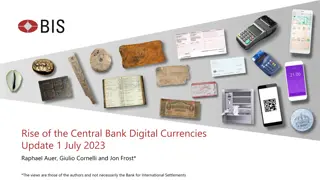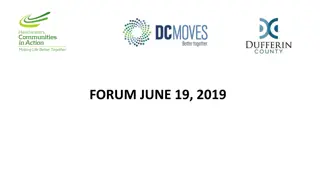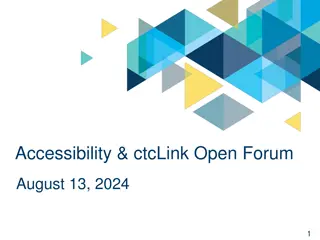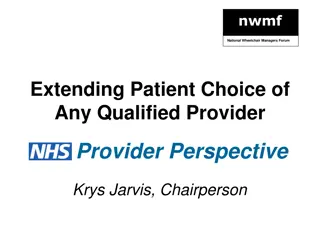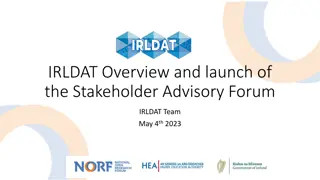
Managing Risks and Revenue Models for Digital Pound Intermediaries
Explore the core functions, revenue sources, and regulatory framework for potential Payment Intermediaries (PIPs) in the digital pound ecosystem. Gain insights on revenue drivers, obligations, and risk management strategies. Join the discussion on key considerations for PIPs in the evolving financial landscape.
Download Presentation

Please find below an Image/Link to download the presentation.
The content on the website is provided AS IS for your information and personal use only. It may not be sold, licensed, or shared on other websites without obtaining consent from the author. If you encounter any issues during the download, it is possible that the publisher has removed the file from their server.
You are allowed to download the files provided on this website for personal or commercial use, subject to the condition that they are used lawfully. All files are the property of their respective owners.
The content on the website is provided AS IS for your information and personal use only. It may not be sold, licensed, or shared on other websites without obtaining consent from the author.
E N D
Presentation Transcript
CBDC Engagement Forum 29 April 2024
Agenda 1. Welcome (10 minutes) 2. Intermediaries Roundtable discussion (40 minutes) 3. Blueprint Framework (10 minutes) 4. Working groups update (15 minutes) 5. AOB (10 minutes)
Intermediary Proposition Roundtable discussion Bank of England
The d CP proposes high-level PIP functions. Over the design phase we will make these more granular and precise. The 2023 Consultation Paper says intermediaries (PIPs & ESIPs) deal with all user facing interactions, including wallets and value-added services Based on the 2023 Consultation Paper definition, intermediaries (PIPs) will provide three core functions: Providing users with digital pound accounts Initiating & receiving payments The user wallet Minimum additional functionality: View balances and transaction history Ability for users to close or switch between wallet providers PIPs offer pass-through wallets to end-users of d PIPs are responsible for, and undertake KYC PIPs anonymise personal data before sharing with the BoE PIPs send messages to the BoE to transfer holdings between ledger accounts PIPs to be held to at least the same standards as current PSPs on preventing AML/CTF and fraud Question 1 What clarity do potential PIPs require with regards to their core functions and obligations?
Understanding the possible sources of PIP revenues will be essential in evaluating the commercial viability of a d . The 2023 Consultation Paper says it is essential there are commercial opportunities for PIPs and ESIPs in the digital pound system. Given the wide range of business models and commercial propositions that could offer digital pound services, it would be for the management of those firms to determine the appropriate revenue models. Question 2 What are the most significant revenue and cost drivers for payment service providers currently? How would those translate to D intermediaries?
A framework to manage end-to-end risks in the digital pound ecosystem is essential. The 2023 Consultation Paper says PIPs and ESIPs would be robustly yet proportionately regulated to ensure resilience, continuity of operations and protection of customers. [ ] The regulation governing them would be 1) based on the precise activity performed, 2) proportionate to the risks they pose to themselves and the wider financial system, and 3) agnostic to the nature of technology. Question 3 What are the key commercial and regulatory considerations for firms considering becoming PIPs?
Promoting innovation is one of the primary motivations for the digital pound. The 2023 Consultation Paper says The digital pound would provide public infrastructure with low barriers to entry to promote innovation, and technical standards for interoperability. Question 4 How can we lower barriers to entry and encourage innovation?
Roundtable discussion questions What clarity do potential PIPs require with regards to their core functions and obligations? What are the most significant revenue and cost drivers for payment service providers currently? How would those translate to D intermediaries? What are the key commercial and regulatory considerations for firms considering becoming PIPs? How can we lower barriers to entry and encourage innovation?
Blueprint Framework Bank of England
Blueprint Framework In the Consultation Paper Response, the Bank and HM Treasury highlighted four workstreams for the design phase: Experimentation and proofs of concept Blueprint National conversation Assessment The Blueprint is a comprehensive proposition for the digital pound. This will incorporate the design principles for a digital pound and help to assess the costs, benefits and viability of a digital pound. The Bank will soon publish a design note setting out the framework for the Blueprint.
The blueprint framework components Scheme and Regulation
Questions for discussion Do the high level components we propose for a blueprint appear sufficient? What components of the blueprint are most important in helping the private sector determine what services they might provide in a d ?
Privacy working group - Questions to consider Is there a range of levels and types of privacy that could be offered in a digital pound ecosystem that remains within the principles set out in the Consultation Paper? If so, what are the advantages and disadvantages of different options to the full range of actors in a digital pound ecosystem? How and where do existing legal and regulatory safeguards pose a challenge to different levels of privacy? How much and what kind of information should users have about how their data is used in a digital pound ecosystem, and what impact will this have on merchants and other participants processing payments? What are the main considerations for the introduction of tiered wallets, enabling consumers to choose different levels of privacy depending on access to services?





